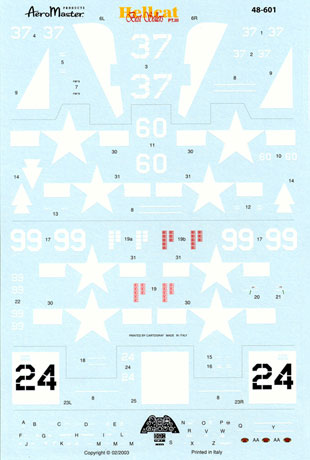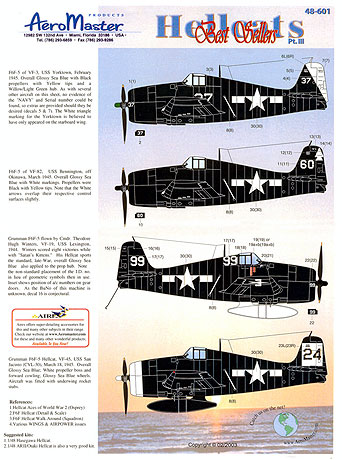S u m m a r y
|
| Catalogue
Number: |
AMD 48-601 - Hellcat Best
Sellers Part III |
| Scale: |
1/48 |
| Contents and Media: |
Waterslide decals - Decal
sheet plus instructions and notes |
| Price: |
MSRP USD$10
available from Aeromaster's website |
| Review Type: |
FirstLook |
| Advantages: |
Perfect register; thin;
minimal carrier film; good instructions and background;
conjectural markings included for Hangar Lillies |
| Disadvantages: |
|
| Recommendation: |
Recommended |
Reviewed
by Rodger Kelly

Aeromaster Decals' 1/48 scale Hellcat Best Sellers Part III will be available
online from Squadron.com
Aeromaster have recently taken
to re-releasing some of their earlier sheets in a different format
from the original issues. This sheet is one of them. Two of the
aircraft first appeared on sheet number 48-251, one on 48-380 and the
final option on the “Specials” Tokyo Raiders sheet.
48-601 features four F-6F-5s
all of them in overall glossy sea blue camouflage with three of them
carrying the late-war white geometric carrier identification designs.
 First
up is 37, an aircraft of VF-3 whilst based on the USS Yorktown in
February 1945. Nothing special here, apart from a green propeller
dome. First
up is 37, an aircraft of VF-3 whilst based on the USS Yorktown in
February 1945. Nothing special here, apart from a green propeller
dome.
-
37 is worn on either
side of the fuselage, vertical stabilizer, engine cowling and the
forward facing main gear doors.
-
The geometric design
for the rudder and top of the starboard wing are supplied as
decals. The trim tab is not included on the rudder decal.
Available photos of other aircraft within VF-3 from this time period
show the trim tab in white but there is a photograph in the old
Kookaburra Markings of the Aces Part 2 U.S. Navy book that shows
this aircraft running-up prior to launch with the trim tab deflected
fully to the left giving the appearance that it was not painted.
Perhaps this is the reason that Aeromaster have not included the
trim tab as part of the decal.
-
Convention has it
that the geometric designs appeared on the upper right wing and the
lower left wing. However, it is thought that USS Yorktown based
aircraft only wore the design on the right wing. Aeromaster have
hedged their bets and suppled two of the wing geometric designs –
your choice!
-
Similarly,
Aeromaster have also supplied the Bureau number and aircraft
designation although there is no evidence that it was painted on the
aircraft – my bet is that it was! The aircraft designation is in
black; normally it was in white on glossy sea blue aircraft and
painted on the top of the rudder. It would have been covered by the
geometric design on this aircraft and Aeromaster have again hedged
their bets here and supplied it in black.
Next is a VF-82 aircraft from
the USS Bennington as it appeared off Okinawa in March of 1945. A
very standard aircraft with a black propeller dome.
-
60 is worn on either
side of the vertical stabilizer as well as the forward facing main
gear doors.
-
USS Bennington’s
geometric design was an arrowhead and these are provided for either
side of the rudder and the top of the right wing.
-
Bureau number and
aircraft designation are also provided for the fin and rudder
respectively.
The third aircraft is from
VF-19 and a very early CAG bird. It was flown by Commander Theodore
H. Winters from the USS Lexington in 1944
when he was the commander of Air Group 19. Standard finish with a
glossy sea blue propeller dome.
-
99 on the vertical
stabilizer, cowling, on the spine behind the cockpit and on the
forward facing main gear doors.
-
Kill markings in the
form of eight Rising Sun flags. These markings have been provided
as a one part decal as well as separate red and white decals to
address any problem that might arise with register – not an issue on
my sample.
-
Artwork in the form
of a Lilly flower with the script “Hangar Lilly” for either side of
the fuselage below the windscreen.
-
CMDR T.H. Winters
scripts for either side of the fuselage below the cockpit.
The final option is from VF-45
whilst based aboard the USS San Jacinto as it appeared on 18 March,
1945. Standard finish with a white propeller dome the forward part of
the cowling painted white.
-
Small 24s for the
forward facing main gear doors.
-
USS San Jacinto’s
geometric design of a white square for the vertical
stabilizer/rudder and the top of the right wing. The vertical
stabilizer/rudder design features the aircraft number (24) in black
with glossy sea blue blocks that reveal the Bureau number- no doubt
these blocks resulted in the Bureau number being covered in tape
whilst the white square geometric design was painted on.
-
A fictional Bureau
number is also provided as the correct ones (there were two Hangar
Lillys) are not known.
 There
are sufficient white national insignia provided for two aircraft with
a white stripe stencil marking (they mark the step positions in the
fuselage sides) for each aircraft. There is also a complete set of
stencil data for one aircraft. The latter stencil data decals did not
appear on any of the original Hellcat sheets and are a straight
reprint of the original stencil data sheets. There
are sufficient white national insignia provided for two aircraft with
a white stripe stencil marking (they mark the step positions in the
fuselage sides) for each aircraft. There is also a complete set of
stencil data for one aircraft. The latter stencil data decals did not
appear on any of the original Hellcat sheets and are a straight
reprint of the original stencil data sheets.
The placement guide is in
Aeromaster’s norm form of a double-sided, full colour A-4 sized
sheet. It shows side profiles of each aircraft as well as a plan view
of the wings of each aircraft and comprehensive stencil data
diagrams. The placement guide also provides a list of references.
The reference list does not include the Osprey “Hellcat Aces of WWII.
If you plan on building a Hellcat this book is well worth the purchase
price. It also has some excellent reference photos for the VF-19
option.
The recommend kits are the
Arii/Otaki and Hasegawa ones. Should you opt for the Arii/Otaki kit
be aware that it is an F6F-3 kit and will require modification to
bring it up to F6F-5 specs – not an onerous task really. If you
choose to go this route try and borrow a Hasegawa instruction sheet as
it provides you with a clear guide for the necessary modifications.
The decals have been printed
in Italy by Cartograf and are well up to their high standards. The
placement guide and decal sheet are packed in a clear plastic zip-loc
bag.
This is an excellent decal
sheet. Aeromaster have gone that extra bit and provided conjectural
markings as well as a complete set of stencil data.
Recommended. |
Home | What's
New | Features
| Gallery |
Reviews | Reference
| Forum
| Search